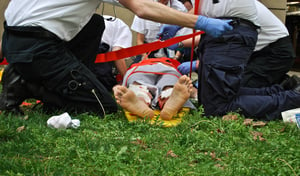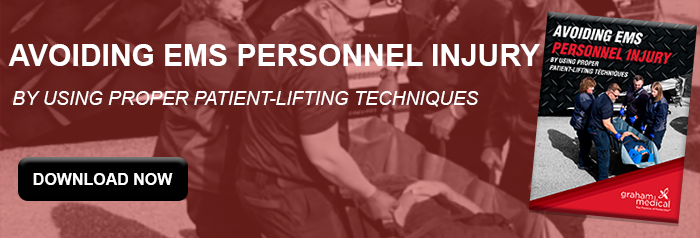 According to the United States Bureau of Labor Statistics (BLS) work-related musculoskeletal disorders (MSDs) account for one-third of the reported causes of lost/restricted work time. Treating these work-related injuries as “just part of the job” for EMTs can have serious physical consequences for your team and those they care for. This JEMS article notes that 62% of pre-hospital provider back injuries alone are due to lifting and carrying patients.
According to the United States Bureau of Labor Statistics (BLS) work-related musculoskeletal disorders (MSDs) account for one-third of the reported causes of lost/restricted work time. Treating these work-related injuries as “just part of the job” for EMTs can have serious physical consequences for your team and those they care for. This JEMS article notes that 62% of pre-hospital provider back injuries alone are due to lifting and carrying patients.
Further, The National Safety Council states, 35% of all work-related injuries are due to overexertion — a contributing factor to MSDs. As such, taking steps to mitigate the risk of overexertion will reduce strain on your team and the patients they serve. It also lowers the risk of potentially costly workman’s compensation claims.
Training your teams is key to minimizing their risk of an overexertion injury and MSDs. This training may cover multiple approaches to injury prevention, such as: raising awareness about factors that contribute to lifting-and-carrying injuries, targeted fitness training and training in proper lifting techniques. Here’s a quick sample of what you should cover:
Contributing factors to lifting-and-carrying injuries
Lifting-and-carrying injuries can occur as a result of a number of contributing factors, including:
- Lifting with extended arms.
- Lifting when near the floor.
- Lifting when sitting or kneeling.
- Lifting with a twisted trunk, or with the load off to the side of the body.
- Lifting with one hand, or in a restricted space.
- Lifting during a shift lasting more than eight hours.
The above-cited JEMS article simplifies these into three major categories: significant lifting forces, repetitive movements and awkward positions.
Prevention is better than cure
Lessen the risk of injury with exercises that promote physical fitness and strengthen the muscle groups associated with lifting and carrying. The American Council on Exercise (ACE) and National Association of Emergency Medical Technicians (NAEMT) joined together to create a fitness guideline for EMTs. It outlines customized workouts, with three exercises specifically designed to avoid back injury:
- Bird dog: On hands and knees, fully extend your right arm and your left foot. Draw imaginary boxes in the air and then alternate, doing 15–30 reps per side.
- Bowler’s squat: Bring your arms up while you squat with your right leg back. Slowly lower and raise your body. Alternate legs and do three sets of 10–15 reps per leg.
- Kettlebell swing: Use a kettlebell swing to hone balance and technique, and train lifting with your legs.
Techniques for correct, safe lifting
Pre-existing fitness must work in combination with correct lifting and carrying technique to keep the risk of injury at a minimum. Basic techniques for EMTs when lifting include:
- Getting as close to the person being moved as possible, and then assuming a firm stance with both feet even and a shoulder-width apart.
- Squatting with knees and hips flexed, while keeping the back straight.
- Tightening the abdominal muscles and pushing down with the feet to tighten thighs and hips.
- “Drag when you can.” In certain compromised situations it may be safer to forego lifting and drag the victim until you reach a place where more responders are available to help with carrying.
Without proper precautions, tools and training, the risk of career-ending injury for EMS personnel can remain unnecessarily high — it affects one in four personnel within their first four years of service. Even if these are avoided, EMS practitioners are seven times more likely to miss work due to injury, compared to the average worker. This has logistic and financial implications on your ability to provide for your team and the communities you serve.
Luckily, partnering with the right medical equipment supplier can do more than just address the needs of your patient. Equipment like Graham Medical’s MegaMover® Portable Transport Units are designed for the needs of the EMTs who use them to dispense care. These compact, cost-effective, portable units are designed with ergonomic lifting in mind for increased safety.
MegaMover® products are:
- Easy to use: Civilians can assist if you’re low on personnel.
- Easy to transport: They’re lightweight and strong to enable quick loading and unloading.
- Compact: Minimal storage space is required, each rig can accommodate multiple units.
- Designed to be dragged or carried: The MegaMover® Disaster Response and MegaMover® Tactical are suitable for large and small teams. Drag straps mean even a single responder can safely transport a victim. Both units are capable of transporting up to 500 lbs.
- Ergonomically designed: The MegaMover® Select and Disaster Response models have handles that offer optimal lifting positions.
This is just a beginning. Dig into our guide for more information on injury prevention, treatment and how the right equipment for the job can make patient transport easier and safer.

